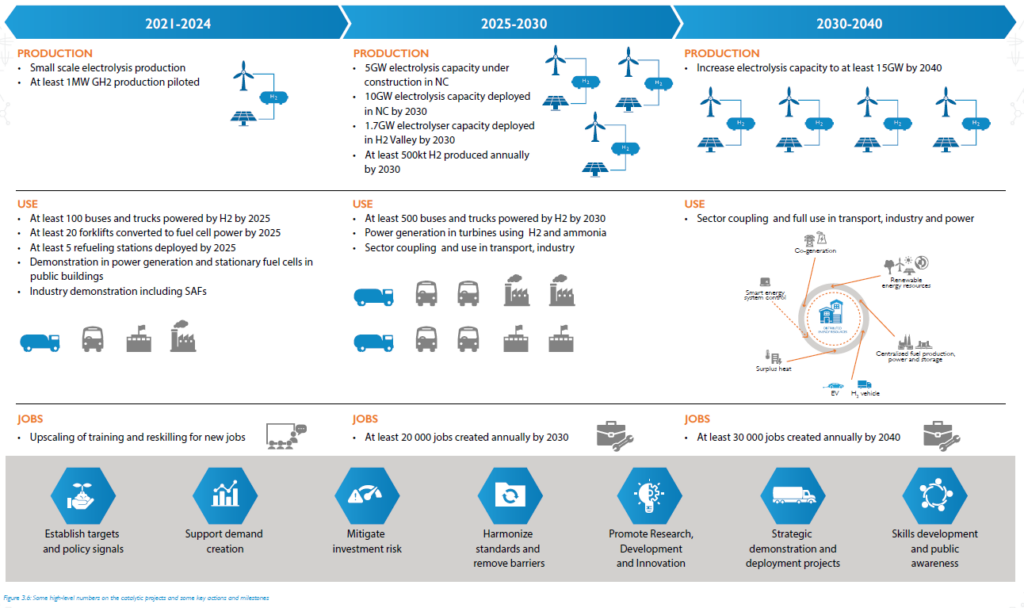South Africa launches Hydrogen Society Roadmap
By Julian Atchison on February 19, 2022
500,000 tonnes by 2030
South Africa’s Department of Science & Innovation launched its highly-anticipated Hydrogen Society Roadmap this week. A total of seventy priority actions for the government have been identified, which fit into the country’s wider goal of a just, inclusive transition to net-zero emissions by 2050. Where hydrogen & ammonia are concerned, high level outcomes include:
- Decarbonisation of heavy transport and energy-intensive industries (cement, steel, mining and refining).
- A greener power sector, both via increases in renewable energy generation, and an increased role for alternative fuels.
- Building hydrogen supply chains domestically, including manufacturing key components.
- Creating an export market for South African green hydrogen & ammonia.

The Roadmap also emphasizes that demand for & consumption of green products within South Africa must be promoted by the government. There is no indication though whether a mandate for the use of a certain percentage of green feedstock will be introduced, like we have seen in India. The Roadmap also comes with a series of milestone targets:
- Small-scale electrolysis deployed by 2025, with a 1 MW facility piloted.
- 10 GW of electrolysers will be deployed in the Northern Cape region and 1.7 GW in the “Hydrogen Valley” by 2030.
- 500,000 tonnes of green hydrogen produced country-wide by 2030.
- Use of hydrogen & ammonia in power generation by 2030.
- At least 15 GW of electrolysis deployed country-wide by 2040.
These milestones will be achieved by four large-scale, “catalytic” projects.
Four “catalytic” projects
We’ve already reported on two of the four at Ammonia Energy. The “Hydrogen Valley” project will link Anglo American’s platinum mine in Mokopane to Johannesburg in the country’s interior, before heading south to the Port of Durban. New transmission lines & hydrogen transport infrastructure will link up a series of production plants and end-use applications (primarily transport, heavy industry and mining).
In the Northern Cape, national energy company Sasol is leading development of the Boegoebaai green fuels project. A deep water port will be constructed next to a sprawling 240,000 hectare site, with 30 GW of wind and solar energy powering 10 GW of electrolysers (to be fully deployed by 2030). An ammonia production plant will produce green ammonia, partly for use as a maritime fuel but also as a feedstock for the third “catalytic” project. A full 25% of hydrogen production at Boegoebaai has been earmarked for ammonia production & subsequent coastal transport to Richards Bay on the other side of the country, where an existing railway line will take the ammonia into Mpumulanga, South Africa’s traditional coal heartland.

In Mpumulanga, the COALCO2-X project aims to use green hydrogen and pollutants from coal power station flue gas to create value-added products. Sequestered carbon will be reacted with green ammonia from Boegoebaai to manufacture fertiliser salts, which can be exported. As coal use declines, project proponents plan for COALCO2-X to help retain skilled jobs within the region, as well as creating a unique economic linkage between the Northern Cape & Mpumulanga.
The final “catalytic” project – the Sasol sustainable aviation fuels project – has no explicit ammonia links. But, deployment of the required electrolysers will be carried out by Linde and ITM Power – the same duo who were recently selected to build the demonstration electrolysis plant at Yara’s Porsgrunn ammonia plant. The project will produce an aviation fuel product meeting all necessary requirements of H2Global’s certification scheme.
A just transition
In November 2021, South Africa was granted a significant financial assistance package from the EU, UK and US to support their decarbonisation efforts. A key condition of this funding was commitment to a just, equitable transition, and this notion now sits at the very heart of this new Roadmap. Retaining jobs in traditionally fossil-heavy locations, re-skilling workers in fossil-reliant industries and creating full value chains are key elements of the four “catalytic” projects. There is also a focus on improving participation rates of women in the emerging industry, and a commitment to investment in the human capital required to see the transition occur.
A recording of the launch webinar can be viewed here. Download the full pdf of the Roadmap here.